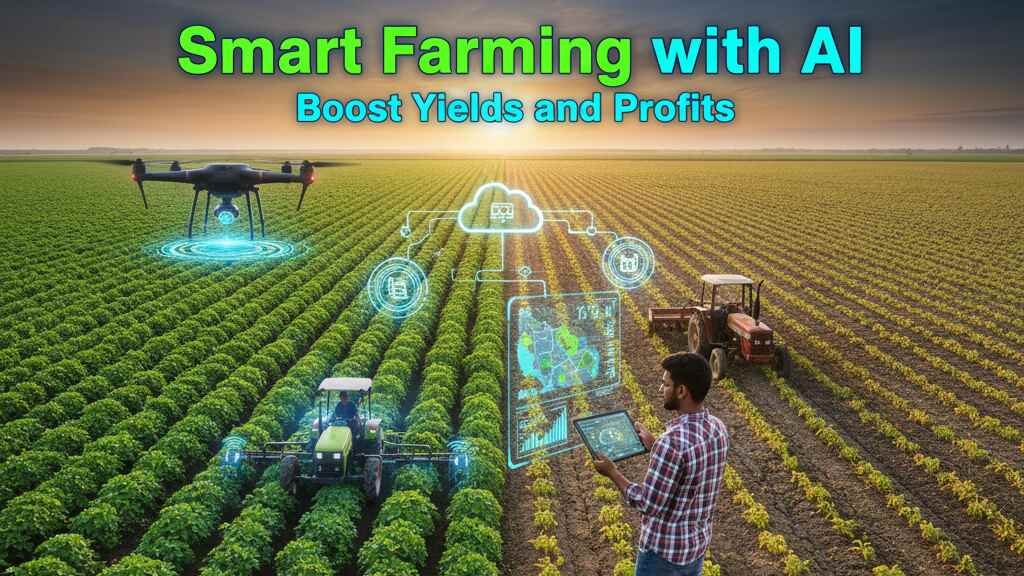If you want to get the most out of farming, you need to embrace new technology. Smart farming with AI is changing how farmers grow crops, improve yields, and earn better profits. With the right methods, even a small farm can use artificial intelligence to make better decisions, save time, and cut costs. But how does this technology really improve farming? Let’s explore how smart farming with Artificial Intelligence ntelligence is making a difference for farmers today.
What is Smart Farming?
Smart farming with AI means using artificial intelligence tools to analyze data, automate tasks, and optimize crop management. It includes everything from weather prediction and soil analysis to automatic irrigation and pest control. Instead of relying on guesswork, farmers can now use smart sensors, drones, and AI-powered apps to gather and process real-time data from their fields. This approach helps make every farming decision more efficient and accurate.
How Smart Farming with AI Works
Data Collection and Analysis
The core of smart farming with AI is data. Sensors and IoT devices installed in the field collect valuable information about soil moisture, temperature, plant health, and weather changes. All of this data goes to an AI system, which processes it quickly. The system then provides farmers with suggestions on when and how much to water, the best time for planting and harvesting, and even alerts for disease or pest risks.
Precision Agriculture Benefits
One huge advantage of smart farming with AI is precision. AI helps target the exact needs of each part of your field. For example, it can identify which sections need more water or fertilizer and which do not. This precise approach boosts crop yields while reducing waste. Farmers save money on resources like water, fertilizer, and pesticides, while protecting the environment by using inputs only when and where needed.
Automated Farming Tasks
Many routine farming tasks are now automated, thanks to smart farming. Tractors and harvesters equipped with AI can plant seeds, spray crops, and harvest produce accurately and quickly. Drones powered by AI can scan large fields in minutes, spot crop issues, and even spray treatments exactly where required. As a result, labor costs go down, and farmers spend less time doing repetitive jobs.
Smarter Pest and Disease Management
AI’s ability to predict pest attacks and disease outbreaks has become a game-changer. Using weather data and historical trends, smart farming with AI can forecast when and where pests or diseases might hit. Early warnings help farmers act fast, saving crops and preventing losses. Some AI tools offer image recognition that spots affected plants before the problem spreads.
Boosting Profit with Better Decisions
Every farm aims to improve profits, and smart farming makes this much easier. Since the technology helps optimize everything from sowing to harvesting, crop yields go up. At the same time, resource costs and losses go down. AI also supports market analysis, suggesting the best time to sell produce for maximum returns. Good decisions, guided by real data, add up to higher profits year after year.
Accessibility for Small and Large Farms
While big farms were the first to use smart farming with AI, affordable technology is now helping small farmers too. Many low-cost sensors and mobile apps are designed for individual growers. You don’t need massive investment to get started. A farmer with a smartphone can access weather forecasts, crop alerts, and market prices in just a few taps. This means everyone has a chance to benefit from smart farming advancements.
Practical Steps to Start Smart Farming with AI
Thinking about implementing smart farming on your farm? Here are some easy steps to begin:
- Start with a soil or weather sensor in a small area.
- Use a mobile app that tracks crop health and market trends.
- Try AI-powered tools for pest or disease alerts.
- Expand as you see results, adding more automation or data analysis tools.
- Stay updated by following agriculture innovation news and local experts.
You don’t have to switch everything at once. Even small changes can lead to much better results over time.
Final Thoughts
Smart farming with AI is not just for large farms. Anyone can use this technology to grow more, use fewer resources, and increase profit. By adopting AI-powered solutions, you make your farm more efficient, resilient, and ready for the future. This new approach helps you get the best crop yields season after season.
Also Read: AI vs Human Intelligence: Can Machines Think Like Us?






